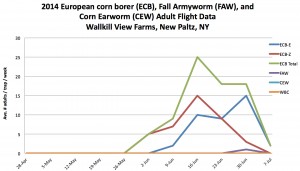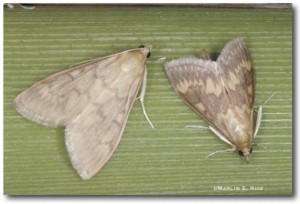Full Scouting Report for July 8th 2014
The trap catch data from New Paltz and Warwick this week indicates a slight decline in the number of adult first brood European corn borers (ECB). Corn earworm (CEW) and Fall armyworm (FAW) adults were not observed in our traps. CEW’s and FAW’s usually arrive in the Mid-Hudson Valley by the end of June. 

The optimum time to apply insecticides to control the first generation ECB larva is during the late whorl to early tassel stage. As noted in last week’s report, we did catch one Fall armyworm (FAW) on 17 June but none were caught this week. Corn earworm’s (CEW) have not yet been observed in any of our traps. Field scouting should be ongoing in all fields that are in the whorl and silk stage for the presence of all three major insect pests. Once the CEW’s arrive, a five day spray interval is recommended when the weekly trap catch is not greater than seven CEW’s
ECB feeding damage on newly emerging tassel is usually accompanied by white or light brown frass the size of fine sand (see photo below). ECB larvae may also be visible. The worm is cream or light pink in color with a reddish-brown or black head and about 26 mm in length. Typical examples of ECB feeding are a series of straight line pinholes as well as “window pane” damage on the emerging leaves from the whorl. Window pane damage occurs when the young ECB larvae feed on the upper epidermal of the leaf leaving a clear lower level epidermal ‘window’.
Corn Earworm adults have not yet arrived in significant numbers in the Mid-Hudson Valley with low numbers in E. LI.
Western Bean Cutworm (WBC) adults have not yet arrived in Eastern New York with the first reports of WCB in NY on the 2nd of July at the Kennedy site in Chautauqua County, Oswego County, Pavilion in Genesee County and Seneca Castle in Ontario County.
Western NY: The first report of corn earworm (CEW) occurred on the 17th of June at the Eden site in Erie County and one fall armyworm (FAW) in Avoca. Of twenty-one WNY sites reporting this week, European corn borer (ECB-E) was caught at five sites and ECB-Z was caught at four sites. Corn earworm (CEW) was caught at 4 of the reporting sites with one of the six sites reporting CEW indicating a need for a 6-day interval control program.
During scouting of corn at tassel, corn leaf aphid, Rhopalosiphum maidis (Fitch), was observed. Treatment threshold for corn leaf aphid at tassel emergence is 50% of plants with >20 aphids per plant.
PA: Southwestern PA has highest CEW populations with 9.1 CEW per day captures at the end of June. Eastern PA, Slatington in Lehigh County County, PA, near central NJ, showing 1 CEW per day captures with 0.83 ECB captures per day. Highest ECB trap numbers in the state average of 14 /day in Hornbrook, Bradford County, PA. In Ransom, Lackawanna county toward the Northeastern part of the state, WBC numbers are very low with daily catch of 0.14 /day.
Japanese beetle (Popillia japonica) (JB) have been observed over the past week in tree fruit. It’s not an uncommon scouting observation to see JB in organic and low spray fields feeding on corn silks.

